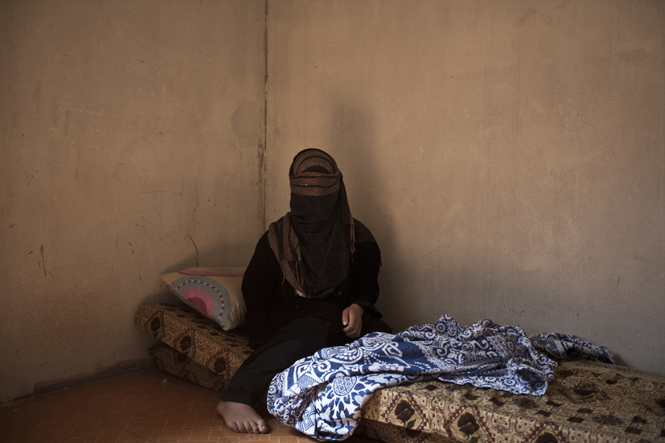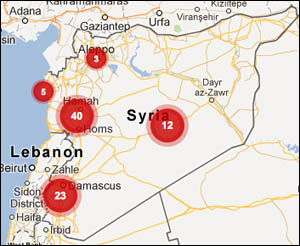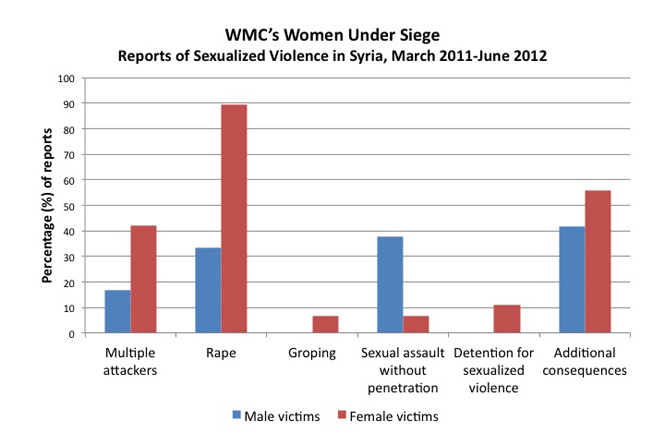The ultimate assault: Charting Syria's use of rape to terrorize its people

Zaynab, 16, comes from the Khalidiya neighborhood of Homs, Syria. An honor student, Zaynab stopped attending classes after soldiers kidnapped, raped, and killed some of her schoolmates in January, she told the photographer. She’s currently in Lebanon. (Matilde Gattoni)
A woman swathed in black squares her shoulders and calmly looks into a camera. She holds a Quran. Only a sliver of her face—her eyeglasses—shows. “What happened to me hasn’t happened to anyone, or if it has affected anyone else I do not know,” she says. “But I will speak and let all the people know what [Syrian leader] Bashar al-Assad and his men are doing.” Over the next four minutes, her breathing grows labored and her voice breaks as she describes how, in May 2011, five men wearing black entered her home on the outskirts of Homs and raped her.
“This is my message to the world,” she says. “Let all the world hear what is happening to us. And I might not be the first one nor the last who was treated in this way.”
The still-unidentified woman posted the video to YouTube on February 11, 2012. It is one of the earliest reports on our live, crowd-sourced map of sexualized violence in Syria. The Women’s Media Center project Women Under Siege has been collecting reports out of Syria for three months, during which time we’ve seen many stories similar to this, in which multiple attackers, usually government forces, are said to gang rape a woman in her home. We have also mapped stories at the extreme edge of nightmares; of teenage girls given shots that immobilize them while their genitals were burned or filled with mice. Government forces and others appear to be carrying out appalling sexualized attacks against women, men, and children in Syria as the conflict there continues. Although we are unable to independently confirm these stories—Syria is simply too dangerous, and our research staff too small—they are consistent both internally and within the news and NGO reports telling similar stories from the Syrian conflict.
 Click the image to see the live crowdmap. |
To step back from the red dots on our map and try to understand the sexualized violence of Syria’s war, our team of doctors, activists, and journalists has taken the 81 stories we’ve gathered so far, from the onset of the conflict in March 2011 through June 2012, and broken them down into 117 separate pieces of data on everything from rape to the consequences of sexualized violence, such as depression, HIV, and pregnancy. Many more victims are included in these reports, but the vagueness of much of the information does not allow us to give an estimate of the total number. For example, one report tells of an incident in which the Syrian army allegedly raped 36 women while another speaks of a doctor who is treating some of the “2,000 girls and women raped throughout Syria.” Our data, though largely anecdotal, gives us a sense of the scope and impact of sexualized violence in Syria. It appears to be widespread, not limited to any particular city, and often involves rape.
“The data we have so far suggest sexualized violence is being used as a tool of war, although possibly haphazardly and not necessarily as an organized strategy,” said Dr. Karestan Koenen, associate professor of epidemiology at the Mailman School of Public Health at Columbia University and the lead epidemiologist on the mapping project. “These reports indicate that post-conflict intervention will need to address the consequences of sexualized violence for victims.”
Government perpetrators have committed the majority of the attacks we’ve been able to track: 61 percent, including attacks against men and women, with another 6 percent carried out by government and shabiha forces together. These soldiers or officers have allegedly carried out 58 percent of rapes against women; shabiha (plainclothes militia) attackers 14 percent; government and shabiha working together 5 percent; and another or unknown attacker 26 percent. In 42 percent of the incidents of sexualized violence against women that we found, the victims were allegedly attacked by multiple people at once, suggesting a disturbingly high rate of gang rape.
There are well-documented challenges and limitations when it comes to studying sexualized violence in conflict, and our data is not meant to represent the Syrian conflict in its entirety. All of our reports come second- or third-hand, and can’t be independently confirmed. Still, the data provides a small but critical window into Syria’s ongoing violence.

“These new data drawn from reports of sexualized violence crimes in the Syria conflict give us an important initial snapshot of the scale and scope of this horror,” said Susannah Sirkin, deputy director of Physicians for Human Rights, which conducts research and advocacy related to rape in armed conflict.
“The fact that a large portion of the alleged crimes involved multiple attackers indicates possible coordinated, orchestrated, or systematic violence without restraints on the behavior of government and other forces,” Sirkin said. In other words, either Syrian leaders appear to be instructing soldiers to violate women, or the Syrian armed forces have descended into such a Lord of the Flies-style chaos that rape is becoming more routine.
Of the 117 reports, 80 percent of them include female victims, with ages ranging from 7 to 46. Of those, 89 percent reported rape; 6 percent reported groping; 6 percent include sexual assault without penetration; and 11 percent of reports include detention that appears to have been for the purposes of sexualized violence or enslavement for a period of longer than 24 hours. It’s difficult to know intent, but some soldiers have described being ordered to detain women to rape them. We’re keeping an eye out for similarities to Bosnia’s infamous “rape houses,” such as this one in Foča.
Syrian women are suffering more than just sexualized violence itself, with 20 percent of reports leading to the victim’s death, 10 percent to anxiety and/or depression, and 5 percent to pregnancy. “Death” means that women were found dead with signs of sexual assault or they were raped and then killed in front of witnesses, as in this report in which a mother describes watching her three daughters stripped, raped, and murdered by knife-wielding security forces. “You could only hear the screams and the cries of the little ones asking for help, but this did not make them show any mercy,” she recalled.

So far, we’ve found 24 incidents involving men and boys between the ages of 11 and 56 who have also reported sexualized violence as a consequence of the Syrian conflict. Thirty-three percent of reports with male victims allege rape and 38 percent include sexual assault without penetration. Almost 17 percent include multiple attackers. In all but one case, the perpetrators of sexual violence against men were reportedly members of government forces. This is likely due to the fact that most—75 percent—of the reported sexual torture has occurred in detention facilities, staffed and run by the government, where rape and sexual assault appear to be used as a tool of torture. The other 25 percent of reports do not specify the exact location, in many cases because the attack was in the victim’s home—in a number of these, the male victim is forced to watch as his wife or daughter is raped.
“The fact that about a fifth of the reports involve male victims also points to unbridled terror, given the enormous stigma and silence that typically surrounds mass rape of men,” said Sirkin.
The one city that has produced the most reports is Homs, the long-suffering center of protest, with 37 percent of incidents. Surprisingly, the second-most frequent source of the reports is Damascus, the supposedly quiet capital city, with 12 percent of reports.
Our numbers tell us that there is a potentially tremendous human rights crisis unfolding for women, men, and children in Syria. Behind each number though, is a life—a family, or even a whole community—now potentially destroyed by rape and sexualized torture.
Jackie Blachman-Forshay contributed research.
This article also appeared in The Atlantic.
More articles by Category: International, Violence against women
More articles by Tag: Sexualized violence, War, Rape



























